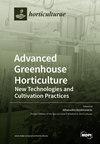Identification of Flavonoid 3′-Hydroxylase Genes from Red Chinese Sand Pear (Pyrus pyrifolia Nakai) and Their Regulation of Anthocyanin Accumulation in Fruit Peel
IF 3.1
3区 农林科学
Q1 HORTICULTURE
引用次数: 0
Abstract
The red Chinese sand pear (Pyrus pyrifolia Nakai) is native to China and exhibits a unique fruit coloration pattern. Flavonoid 3′-hydroxylase (F3′H) catalyzes the hydroxylation of flavonoids, which subsequently determines the components of anthocyanins and the color of plant organs. Two genes encoding flavonoid 3′-hydroxylase (F3′H), PpF3′HI and PpF3′HII, have been identified in red Chinese sand pears. The coding regions for PpF3′HI and PpF3′HII were 1542 and 1536 bp in length, respectively. PpF3′HI shared 95% of its amino acid sequence identity with PpF3′HII, and a highly conserved P450 superfamily domain was found both in PpF3′HI and in PpF3′HII. Phylogenetic analysis showed that PpF3′HI and PpF3′HII clustered with MdF3′HI and MdF3′HII, respectively. PpF3′H genes were highly expressed in anthocyanin-enriched tissues such as young leaves, and transcription of PpF3′H genes corresponded to anthocyanin biosynthesis during the developmental stages, bagging treatment, and postharvest UV-B/visible irradiation treatment. A Y1H assay showed that PpMYB10 and PpHY5 could interact with the −419 bp to 0 bp and −746 bp to −396 bp fragments of the PpF3′HI promoter region, respectively. Understanding the mechanism of flavonoid hydroxylation patterns will, in turn, promote the development of new technologies for modifying flavonoid and anthocyanin composition in fruits.红砂梨(Pyrus pyrifolia Nakai)中黄酮类化合物 3′-羟化酶基因的鉴定及其对果皮中花青素积累的调控作用
红沙梨(Pyrus pyrifolia Nakai)原产于中国,果实着色方式独特。黄酮类化合物 3′-羟化酶(F3′H)催化黄酮类化合物的羟化,进而决定花青素的成分和植物器官的颜色。在中国红砂梨中发现了两个编码黄酮类化合物 3′-羟化酶(F3′H)的基因,即 PpF3′HI 和 PpF3′HII。PpF3′HI 和 PpF3′HII 的编码区长度分别为 1542 和 1536 bp。PpF3′HI与PpF3′HII的氨基酸序列有95%的一致性,在PpF3′HI和PpF3′HII中都发现了一个高度保守的P450超家族结构域。系统进化分析表明,PpF3′HI 和 PpF3′HII 分别与 MdF3′HI 和 MdF3′HII 聚类。PpF3′H基因在幼叶等富含花青素的组织中高表达,PpF3′H基因的转录与花青素在发育阶段、套袋处理和采后紫外线-B/可见光照射处理过程中的生物合成相关。Y1H测定显示,PpMYB10和PpHY5可分别与PpF3′HI启动子区的-419 bp至0 bp和-746 bp至-396 bp片段相互作用。了解类黄酮羟基化模式的机理将有助于开发改变水果中类黄酮和花青素组成的新技术。
本文章由计算机程序翻译,如有差异,请以英文原文为准。
求助全文
约1分钟内获得全文
求助全文

 求助内容:
求助内容: 应助结果提醒方式:
应助结果提醒方式:


